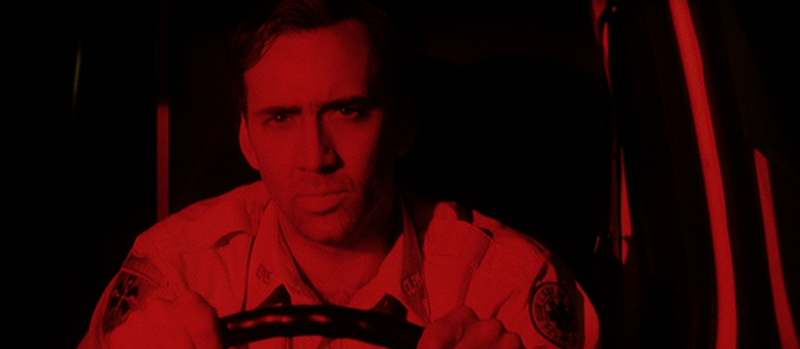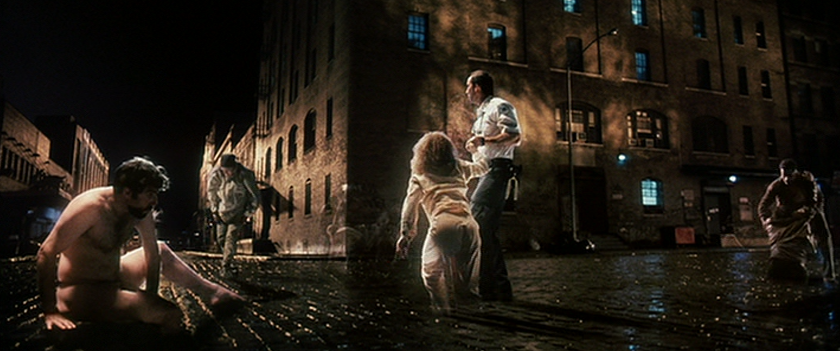

“I realized that my training was useful in less than ten percent of the calls, and saving lives was rarer than that. After a while, I grew to understand that my role was less about saving lives than about bearing witness.”
Nicolas Cage is at his manic best in Martin Scorsese’s overlooked fever dream Bringing Out the Dead, a modern ghost story tinged with magical realism. Cast as paramedic Frank Pierce, Cage is an alcoholic insomniac who is haunted by the spirits of those he failed to save. He tangles with a colorful cast of interesting characters throughout the hectic three days the film captures. Screenwriter Paul Schrader pairs with Scorsese for the fourth time (Taxi Driver, Raging Bull, The Last Temptation of Christ) adapting Joe Connelly’s novel, resulting in a film that touches on Scorsese’s familiar themes: Catholic guilt, New York City, corruption, etc.
Bringing Out the Dead is a different kind of film, though. The audience doesn’t watch a thrilling plot unfold before them. There are no double crosses or secret identities; no grand climax. We’re in New York City; but more specifically, we are in Frank Pierce’s head. As the paramedics drive around the city at night, Frank is frequently tormented by the face of Rose (Cynthia Roman), a teenage asthmatic that died in his arms. In fact, in the opening monologue he tells us that he hasn’t saved anyone in months, and his grip on his sanity is loosening. Creative filmmaking helps Scorsese to portray Frank’s deteriorated state of mind. The pulsating ambulance lights and siren are emphasized; the film is sped up when driving; frantic jump cuts heighten the feeling of anxiety; images blur. From a technical standpoint, the film is expertly shot and edited, and the digital effects are subtle and only used when necessary.

The role of Frank West seems like it was written specifically for Cage, who is given the opportunity to move from serious emotional drama to outrageous antics seemingly on a whim. Credit is due to the make-up team who have Cage looking particularly chewed up, spit out and sleep-deprived with dark bags under his squinting eyes. He alternates between a half-hearted romantic pursuit of Mary Burke (Patricia Arquette, who was married to Cage at the time), the daughter of one of his cardiac arrest patients, and a series of increasingly bizarre episodes with his rotating cast of partners. He begins his first night riding with Larry (John Goodman), which serves to lay the groundwork for the rest of the film. They bring Mary’s father to Our Lady of Perpetual Mercy Hospital, dubbed “Misery” by the paramedics.
The emergency room setting is brilliantly packed full of zany characters. Guarding the door is Griss (Afemo Omilami), a mustachioed security officer who wears sunglasses inside and humorously talks to the people waiting, occasionally resorting to light physical violence to ward off their onslaughts. Like several of the smaller roles, Griss’s character has a function within the setting but is perfectly utilized to bring some levity to the dark subject matter. “Griss cannot abide the funk tonight.” “Don’t make me take off my sunglasses!” Noel (Marc Anthony) is a mentally unstable frequent flyer at the emergency room who weaves in and out of the story, always searching for a cup of water and claiming he has eaten sand. Mary Beth Hurt is a nurse who chastises the overdosers as she takes care of them.
“You say you’ve been snorting cocaine for three days and now you feel as if your heart is beating too fast and you would like for us to help you. Well, to tell you the truth, I don’t see why we should. I mean, correct me if I am wrong here, if I’m mistaken, did we sell you the cocaine? Did we push it up your nose?”

In a recurring discussion, Frank is always promised that the next time he sees his boss that he will be fired. He wants to be fired, and routinely comes in late to force the issue. But there is always something more pressing that requires his service. On our second night with Frank, he is assigned to ride with Marcus (Ving Rhames). Marcus is a flirtatious gospel-spouter who hits on his dispatcher and drinks on the job. The duo end up in a grungy club where musical artist I.B. Bangin’ has overdosed on a new drug known as Red Death, which serves as a kind of MacGuffin. When Frank tells Marcus that he can resuscitate the young man, Marcus makes the drug-addled club dwellers circle up and holds hands while he prays in his best preacher voice, emphasizing syllables that do not exist.
“Dear Lord, here I am again aksin’ one mo’ chance for a sinner. Please Lord-ah. Bring back I. B. Bangin’, Lord-ah. You have the power, Jesus-ah. You have the might-ah. You have the super light-ah to spare this worthless man-ah.”
On the third day, Frank rides with Wolls (Tom Sizemore), a psychotic driver who has a strange view of his job as a paramedic. “Look up, Frank. Full moon. The blood’s gonna run tonight. I can feel it. Our mission: to save lives.” “Our mission is coffee,” Frank says. Wolls seems to be invigorated by death and destruction, and intentionally tracks down the troublemaker Noel and beats him half to death before Frank saves him. The most noteworthy sidetrack here is a faux virgin birth, where a naïve young man swears he and his girlfriend have never slept together, yet Frank delivers twins in their rundown apartment. “It’s a miracle,” the young man says.

Counter-balancing the kinetic speed of Frank’s night shifts are his emotionally resonant scenes with the relapsing Mary. It appears Frank is confused about his own intentions, as his romantic interest overlaps with his compulsion to save her as recompense for his failure with Rose. When he follows her to the Oasis—home of the local drug dealer Cy (Cliff Curtis)—Cy convinces Frank to take a pill that will help him relax. Frank envisions the translucent ghosts of his dead patients clawing their way up from the ground below and he reaches down to help them up. But then his vision replays the episode of Rose dying (the first time we get to see it), and Frank wakes up screaming and carries the unconscious Mary from the Oasis and into the street. The entire dream sequence is one of the film’s highlights, with lots of bizarre imagery and creative sound design (including the perfect inclusion of the song ‘I Am the Japanese Sandman’), and sets up a noteworthy conclusion to Cy’s sidestory.
The film is unconventional in its plotting, and though its story is intricate and detailed, its atypical arc ends with a morally ambiguous decision by its protagonist that is understandable yet heart-wrenching. Though the film shares themes with some of Scorsese’s greats like Mean Streets and Taxi Driver, it feels more akin to his off-the-wall black comedy After Hours than any of his most critically praised films. The humor is integrated tastefully into the grimy paramedic episodes, but the film never shies away from the blood and guts. The supporting cast are excellent (Rhames especially), but it is the perfectly cast Cage who pulls the whole thing together with his ranging performance and his ability to shift gears in the middle of a scene.
While not for everybody—not even all Scorsese fans will like this—Bringing Out the Dead is a great experiment from one of the masters.